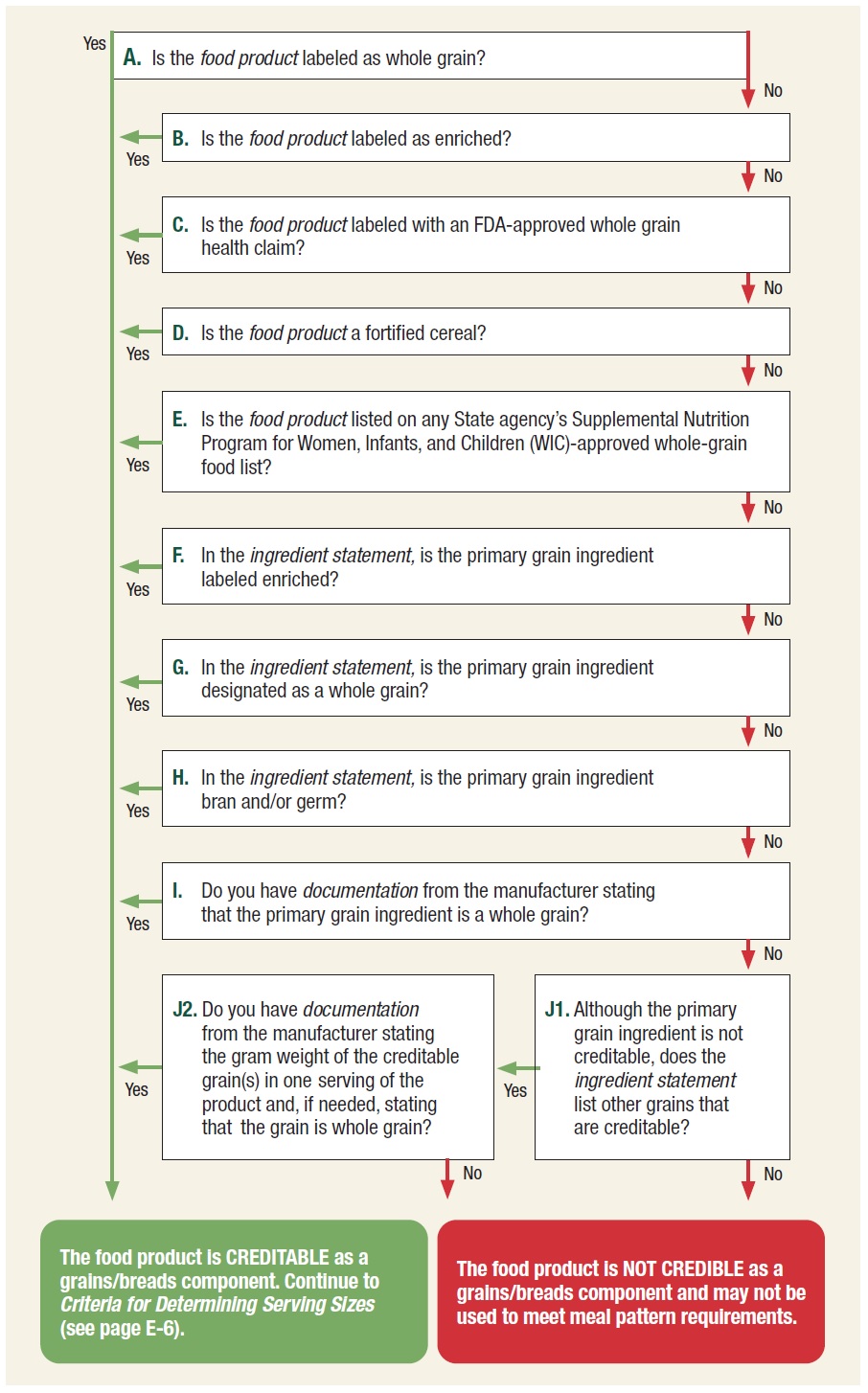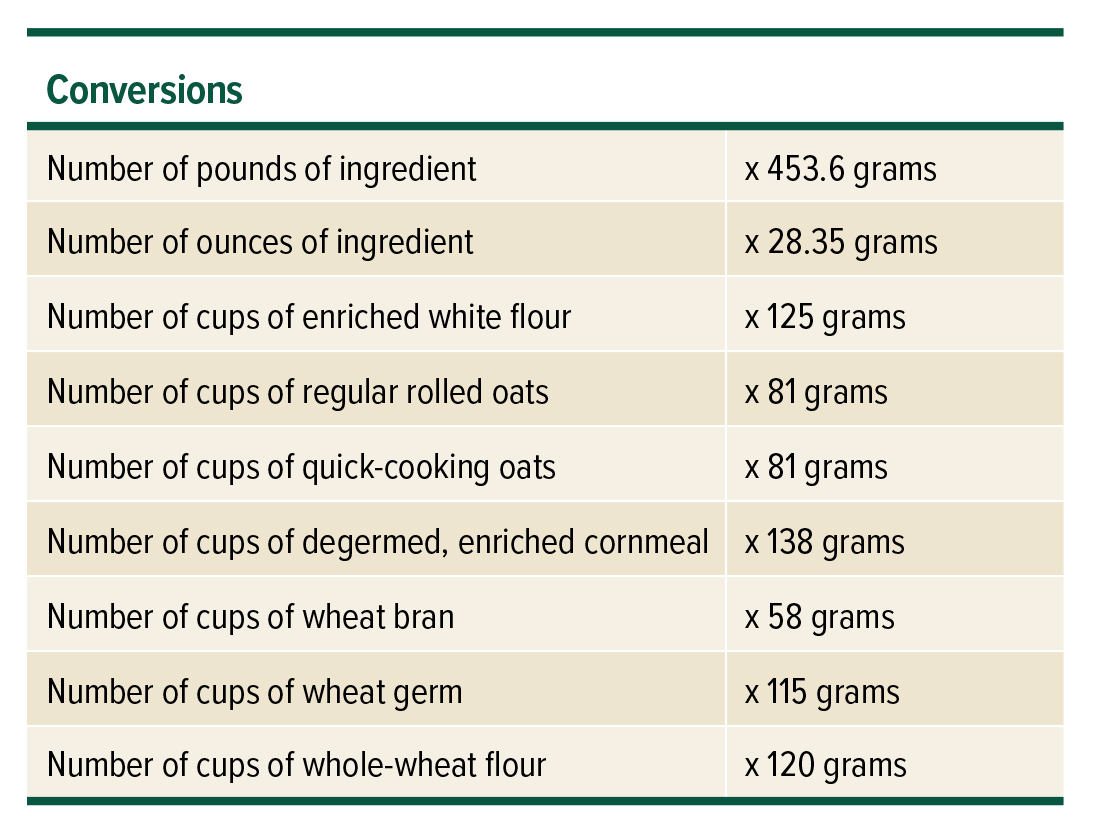To determine if a grain food product is creditable, CNP operators need to verify that the food product is made from whole-grain flour, whole-grain meal, corn masa, masa harina, hominy, enriched flour, enriched meal, bran, germ, or be an enriched product, such as enriched bread, or if it is a cereal, that it is whole grain, enriched, or fortified. See Examples of Foods That Are Creditable Toward the Grains Component for a list of creditable grains ingredients.
The following steps will help you to identify if a food product is creditable towards the grains/breads component. If at any point during the steps a “yes” answer is obtained, proceed to the section “Criteria for Determining Serving Sizes.” If you answer “no” to all of the steps from A to H, the food product is not creditable towards the grains/breads component. Please note that program specific guidance for school meals, NSLP afterschool snacks, and CACFP offers additional options and other information related to identifying creditable grain products. Please verify that grain products are creditable toward the grains/breads component prior to purchase.
- Is the food product labeled as whole wheat or whole grain?
If a food product is made from whole grain, the product name on the label will usually include the word “whole.”
Some examples include: whole-wheat bread, whole-wheat rolls, whole-wheat buns, whole-wheat macaroni products, and whole-grain pasta.
OR
- Is the food product labeled as enriched?
If a food product is enriched, the product name on the label will include the word “enriched.”
Some examples include: enriched bread, enriched rolls, enriched buns, enriched rice, enriched macaroni products, enriched egg noodle products, enriched grits, and enriched cereal.
OR
- Is the food product labeled with an FDA-approved whole grain health claim?
If a food product is labeled with an FDA-approved health claim, the product label will include one of the following on its packaging:
“Diets rich in whole grain foods and other plant foods and low in total fat, saturated fat, and cholesterol may reduce the risk of heart disease and some cancers,” OR “Diets rich in whole grain foods and other plant foods, and low in saturated fat and cholesterol, may help reduce the risk of heart disease.”
OR
- If the food product is a cereal, is it fortified?
(Fortification only applies to cereals. If the food product is not a cereal, continue on to step E). Cereal products that have been fortified will have an ingredient statement similar to the following (for EXAMPLE purposes only):
Ingredients: Corn flour blend (whole grain yellow corn flour and de-germinated yellow corn flour), sugar, oats, contains 2% or less of salt, baking soda, caramel color, annatto color, BHT for freshness.
Vitamins and Minerals: Vitamin C (sodium ascorbate, ascorbic acid), niacinamide, vitamin B6 (pyridoxine hydrochloride), reduced iron, zinc oxide, folic acid, vitamin B2 (riboflavin), vitamin B1 (thiamin hydrochloride), vitamin A palmitate, vitamin D, vitamin B12.
OR
- Is the product listed on any State agency’s Supplemental Nutrition Program for Women, Infants, and Children (WIC)-approved whole-grain food list?
Any grain product found on any State agency’s Supplemental Nutrition Program for Women, Infants, and Children (WIC)-approved whole-grain food list is creditable in SFSP. Program operators can obtain a copy of a State agency’s WIC-approved whole-grain food list by contacting the WIC State agency. For a list of WIC State agency contacts, please see www.fns.usda.gov/wic/wic-contacts.
OR
- Is the primary grain ingredient in the ingredient statement labeled as enriched?
Ingredients that meet the standards for enrichment will include the word “enriched” as part of the ingredient name. This is typically declared on the label with the word “enriched” followed by the usual name of the grain ingredient along with the parenthetical listing of the enriched nutrients.
Some examples include: enriched wheat flour (wheat flour, niacin, iron, thiamine mononitrate, riboflavin, folic acid); enriched cornmeal (…); enriched self-rising flour (…); and enriched farina (…).
Note: While enrichment of whole grain cornmeal is not required, many programs choose to purchase these products for the added nutritional value.
OR
- Is the primary grain listed in the label ingredient statement designated as a whole grain?
A whole-grain ingredient will usually include the word “whole,” “cracked,” “crushed,” or “groats.”
Some examples include: whole-wheat flour, cracked wheat, crushed wheat, buckwheat groats, graham flour (which is another name for whole-wheat flour), brown rice (which indicates that the rice retains the bran layer), old-fashioned oatmeal (also called rolled oats), quick-cooking oats, and whole cornmeal.
Some examples of grains that are whole grains, but are not always clearly indicated on the label as such include: amaranth, millet, and quinoa.
Note: nixtamalized corn, (i.e., corn treated with lime), such as hominy, corn masa, and masa harina are considered whole grain when evaluating products for meal requirements. Nixtamalization is a process that increases the bioavailability of certain nutrients. If the ingredient statement indicates the corn is treated with lime (for example, “ground corn with trace of lime” or “ground corn treated with lime”), then the corn is nixtamalized.
If the label ingredient statement does not clearly indicate the grain is whole grain or enriched, documentation must be obtained from the manufacturer certifying the grain ingredient is whole grain or enriched.
Check with the manufacturer anytime you are unsure if the product meets requirements.
OR
- Is the primary grain listed in the label ingredient statement bran and/or germ?
Bran and germ are two components of grains. While not whole grains, they are nutritious portions of the grains and are, therefore, credited the same as enriched ingredients for all CNP. Bran or germ will be listed along with the name of the grains.
Some examples include: oat bran and wheat germ.
OR
- Is there documentation from the manufacturer stating that the primary grain ingredient is a whole grain?
If the answer is “yes,” documentation will be used to clearly indicate the grain is whole grain. Documentation must be obtained from the manufacturer certifying the grain ingredient is whole grain.
OR
- If the primary grain ingredient in the product is not creditable, does the ingredient statement list other grains that are creditable?
- Is there documentation from the manufacturer stating the gram weight of the creditable grain(s) in one serving of the product and, if needed, stating that the grain is whole grain?
If the answer is “yes to both questions,” documentation will be used to certify that the grain ingredient(s) of the product meets meal requirements.
Some examples of grain ingredients that are not creditable include: bromated flour, corn grits, degerminated cornmeal, degerminated (grain), durum flour, farina, flour, plain flour, self-rising flour, semolina flour, white flour, wheat flour, and stone ground corn. These ingredients may only contribute to the grains/breads component if the ingredient list indicates that they are whole or enriched. You may also obtain documentation from the manufacturer.
If the answer is “no” to all the above steps (A–J), the food product is not creditable towards the grains/breads component of a reimbursable meal. These items may be served as an “other foods” item and used to help round out the meal as well as contribute calories and nutrients.






